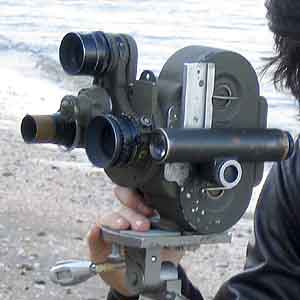Movie camera

The movie camera is a type of photographic camera which takes a rapid sequence of photographs on film; once developed this film can be projected as a motion picture. In contrast to a still camera which captures a single snapshot at a time, the movie camera takes a series of images, each called a "frame". This is accomplished by the camera's mechanism, called the "movement". The frames are later played back in a movie projector at a specific speed, called the "frame rate" (number of frames per second) to give the illusion of motion. Our eyes and brain merge the separate pictures together to generate the illusion, a phenomenon called the "persistence of vision".
Most of the optical and mechanical elements of a movie camera are present in the movie projector. The camera will not have an ilumination source and will maintain its film stock in a light-tight enclosure. A camera will also have exposure control via an iris aperature. Otherwise, the requirements for film tensioning, take-up, inter-frame motion, and positioning are almost identical. See the movie projector article for these details and for the various film formats used.
Video cameras (not movie cameras) can broadly be classified into two categories: analog and digital. Analog cameras are of the "tube" type; they are bulky and generally used in professional studios. Digital cameras are of the "CCD type"; they are light and portable, and generally used for home/office purposes.
The normal frame rate for commercial film is 24 frame/s. The standard commercial film width is 35 millimeters. The standard aspect ratios are 1.85 wide to 1 high (1.85:1) or 2.35:1. NTSC video (common in the U.S. and Japan) has 30 frame/s. The standard video aspect ratio is 1.33:1. In Europe, the most common video format is PAL, which has a different color encoding and frame rate. See the article on projectors for more detailed information.
Many of the technical difficulties involving film and video concern translation between the different formats.
Film is sometimes thought to have nearly perfect image quality. However film resolution is limited by the accuracy of the sprocket holes' placement relative to the image, and the wear of the sprocket holes. In practice film's resolution tops out at something equivalent to 1000 pixels per screen height. HDTV does not have such alignment problems, and is better. One of the current technical proposals to improve film is to have a real-time electronic alignment of the frame, rather than depending on the sprocket holes. This would establish a new, much better resolution limit caused by the graininess of the film.
One of the continuing problems in film is synchronizing a sound recording with the film. No film cameras record sound; instead, the sound is captured by a precision audio device separately. The clapper board which typically starts a take is used as a reference point for the editor to sync the picture to the sound (provided the scene and take are also called out so that the editor knows which picture take goes with any given sound take). It also permits scene and take numbers and other essential information to be seen on the film itself. Aaton cameras have a system called AatonCode that can "jam sync" with an timecode-based audio recorder and prints a digital timecode directly on the edge of the film itself. However, the most commonly used system at the moment is unique identifier numbers exposed on the edge of the film by the film stock manufacturer (KeyKode is the name for Kodak's system). These are then logged (usually by a computer editing system, but sometimes by hand) and recorded along with audio timecode during editing. In the case of no better alternative, a handclap can work if done clearly and properly, but oftentimes a quick tap on the mike (provided it's in frame for this gesture) is preferred.
Some cameras have low-accuracy ("non-sync" or MOS) film-advance systems. One of the most common uses of these cameras in commercial films are the spring-wound cameras used in hazardous special effects, known as "crash cams". Scenes shot with these have to be kept short, or resynchronized manually with the sound. MOS cameras are also often used for second-unit work or anything involving variable or non-standard speed filming. Due to their non-sync nature, some designs forgo traditional low-noise considerations for a studio camera and thus are quite noisy.
The most popular 35mm cameras in use today are Arriflex, Moviecam (now owned by the Arri Group), and Panavision models. For very high speed filming, PhotoSonics are used.
